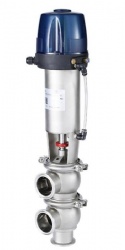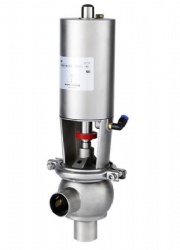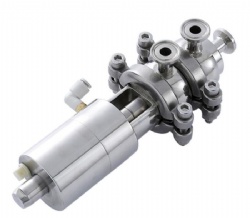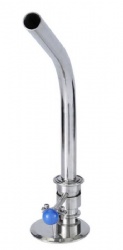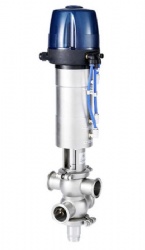Products >> sanitary valves >> sanitary divert valve
sanitary C-TOP divert valve
- Product No.:202151213538
Intelligent control valve is a kind of control valve with microprocessor, which can realize intelligent control function.
The intelligent control valve usually adopts the following forms:
a. Pneumatic control valve with intelligent valve positioner;
b. Intelligent electric control valve; Pneumatic control valve with fieldbus intelligent valve positioner. The intelligent control function mainly includes the following contents
a. It is convenient to modify the flow characteristics of the control valve.
b. Realize PID control operation.
c. Realize other operation functions, such as range setting of split range control, nonlinear compensation operation, etc.
d. Change the positive and negative action mode of control valve.
e. Realize the communication with the host computer, realize the information sharing. L to realize the fault diagnosis and alarm of control valve.
g. Realize the self-locking of the control valve.
h. The advantages of using intelligent valve positioner are as follows.
a. Reduce the installation, calibration and debugging time of control circuit.
b. With the diagnostic function, the control valve can be used. The service life is prolonged and the operation condition can be monitored in time.
c. Reduce the skill requirements for instrument maintenance personnel.
Pneumatic control valve with intelligent valve positioner
The structure of this kind of control valve is the same as that of ordinary control valve. Because it is equipped with intelligent valve positioner, the control valve has intelligent function
1. The flow characteristics of control valve are different
The feedback part of the intelligent positioner adopts linear feedback, and the required flow characteristics of the control valve are realized in the setting circuit. The feedback part of ordinary positioner is cam with different shapes. The flow characteristics of control valve are realized by changing the shape of cam. See section 5.3 for details.
2. Different input and output modes
Generally, intelligent valve positioner is intelligent electrical valve positioner. Compared with the general electric valve positioner, the input signal of intelligent electric valve positioner is the standard 4 ~ 20mA or 1 ~ 5V electrical signal, which needs to be converted by analog-to-digital as the input signal of microprocessor. Although the input signal of the general electric valve positioner is 4-20mA or l-5v electrical signal, it does not need analog-to-digital conversion, and can be directly sent to the electromagnetic coil to generate electromagnetic force and realize force balance. The output signal of intelligent valve positioner is digital signal, which is usually sent to piezoelectric valve group. The pressure of diaphragm head of control valve is adjusted by the switch of piezoelectric valve group. The output signal of general electric valve positioner is the gas signal amplified by pneumatic amplifier.
3. Different control methods are adopted
The intelligent valve positioner is similar to the general computer control device, which adopts discrete control mode. Therefore, the opening of the control valve does not change in the sampling interval. In the process of operation, the opening of the control valve presents a stepped change. General valve positioner adopts continuous control mode, so the change of control valve opening is continuous in the whole control process (except for the jump caused by dead zone).
4. Feedback signal detection and processing are different
The feedback signal of control valve in intelligent valve positioner needs to be processed by microprocessor after analog-to-digital conversion, while the feedback signal of general valve positioner is directly used as feedback force (torque) and does not need to be converted into electrical signal through analog-to-digital conversion. The input signal of some intelligent valve positioners adopts standard analog signal, and Hart digital signal is also transmitted on the same wire to form a mixed signal intelligent valve positioner, which does not belong to fieldbus intelligent valve positioner, but still belongs to intelligent valve positioner.
Previous Product:sanitary welded divert valve
Next Product:sanitary actuator angle divert valve







